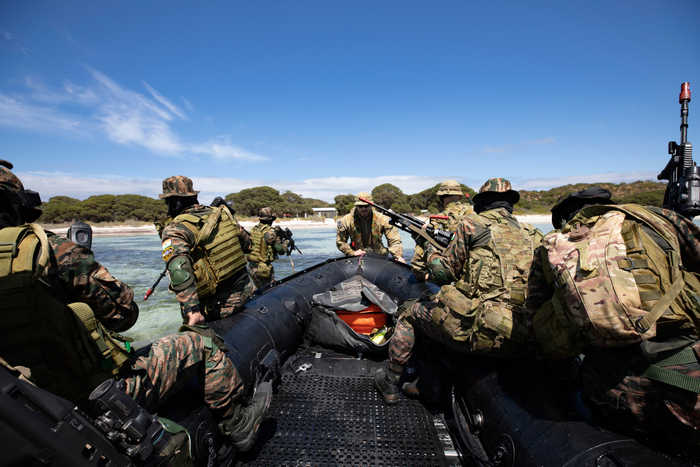Published 16:22 IST, September 11th 2024
India Advances Military Jointness with the Launch of Amphibious Operations Doctrine
The Doctrine highlights the critical role of amphibious capabilities, enabling the Armed Forces to conduct a wide range of operations.
- Defence
- 4 min read
New Delhi, India- In a significant move towards enhancing the operational readiness and jointness of the Indian Armed Forces, Chief of Defence Staff (CDS) General Anil Chauhan unveiled the Joint Doctrine for Amphibious Operations during the Chiefs of Staff Committee (COSC) meeting held on 09 September 2024 in New Delhi.
This keystone publication is set to serve as a crucial guide for military commanders, offering strategic direction for conducting amphibious operations in the increasingly complex and dynamic military environment of today.
Strengthening Amphibious Capabilities in the Indian Ocean Region
The newly released Joint Doctrine underscores the importance of amphibious capabilities for the Indian Armed Forces, particularly in the Indian Ocean Region (IOR). These capabilities are integral to the Armed Forces' ability to conduct a wide range of operations, from humanitarian assistance and disaster relief (HADR) to full-scale military interventions during times of conflict. Amphibious operations exemplify the cohesion and integration among the Army, Navy, and Air Force, demonstrating their ability to operate seamlessly across multiple domains.

Amphibious warfare, which involves the use of naval ships to project ground and air power onto a hostile or potentially hostile shore, has evolved into a complex and sophisticated military operation. The Doctrine outlines the various phases of amphibious operations, including strategic planning, operational transit, pre-landing rehearsals, disembarkation, and the subsequent consolidation of beachheads, followed by inland operations. These operations require meticulous coordination among various military specialities, including air power, naval gunfire, logistics, and specialized equipment designed for amphibious landings.
Amphibious warfare, historically acknowledged as one of the most complex military manoeuvres, involves the coordinated use of naval ships, aircraft, and ground forces to establish a beachhead and conduct inland operations. The Joint Doctrine for Amphibious Operations provides a detailed framework for these operations, outlining the necessary phases, logistical requirements, and the importance of close air support and naval gunfire. The Doctrine also emphasizes the need for specialized vehicles and equipment tailored to the unique demands of amphibious landings.
Armed Forces’ Second Major Joint Publication Issued
The Joint Doctrine for Amphibious Operations follows the earlier release of the Joint Doctrine for Cyberspace Operations, making it the second major joint publication issued this year. This continued focus on jointness and integration highlights the Indian Armed Forces' commitment to preparing for future conflicts in a unified manner. By integrating the unique capabilities of each service, the Doctrine aims to ensure that the Armed Forces can respond effectively to emerging threats and challenges, both within the region and beyond.
Coinciding with the release of the Doctrine, the Headquarters Integrated Defence Staff (HQ IDS) has launched a first-of-its-kind Combined Operational Review and Evaluation (CORE) Programme. The five-day programme, running from 09 to 13 September 2024, is being held at the United Service Institution (USI) in New Delhi and is designed to orient and prepare senior officers from the Tri-Services, as well as representatives from the Ministry of Defence, Ministry of External Affairs, and Ministry of Home Affairs.
CORE to Equip Major Generals for Future Leadership Roles
The CORE Programme has been meticulously curated to equip Major Generals and their equivalents with the skills and knowledge necessary for future leadership roles. The curriculum focuses on strategic planning, anticipation of future threats, and the preparation for conflicts in an increasingly interconnected and technologically advanced global environment. The Programme emphasizes the vital role of military leaders, combatants, and support staff in the effective conduct of future wars, particularly in the context of rapid modernization and the integration of disruptive technologies.

The CORE Programme is structured around a series of panel discussions and lectures delivered by 30 eminent speakers and subject matter experts from diverse fields. Each day of the programme is built around a unique theme, addressing topics such as the changing nature of warfare, the impact of globalization and interconnectedness, lessons from ongoing global conflicts, and the significance of non-kinetic warfare, including cyber and information warfare. Additionally, the Programme will explore the adoption of artificial intelligence (AI) and autonomous systems in military operations, preparing the participants to make informed and comprehensive decisions in future combat scenarios.
Updated 16:22 IST, September 11th 2024